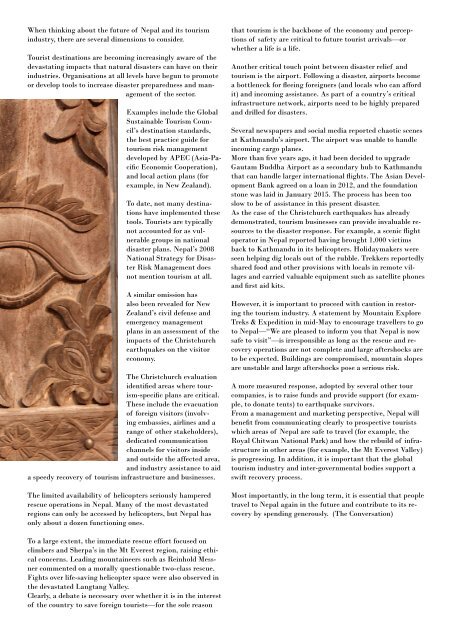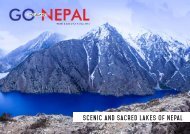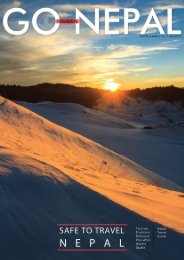Go Nepal e-Magazine
Go Nepal Holiday
Go Nepal Holiday
You also want an ePaper? Increase the reach of your titles
YUMPU automatically turns print PDFs into web optimized ePapers that Google loves.
When thinking about the future of <strong>Nepal</strong> and its tourism<br />
industry, there are several dimensions to consider.<br />
Tourist destinations are becoming increasingly aware of the<br />
devastating impacts that natural disasters can have on their<br />
industries. Organisations at all levels have begun to promote<br />
or develop tools to increase disaster preparedness and management<br />
of the sector.<br />
Examples include the Global<br />
Sustainable Tourism Council’s<br />
destination standards,<br />
the best practice guide for<br />
tourism risk management<br />
developed by APEC (Asia-Pacific<br />
Economic Cooperation),<br />
and local action plans (for<br />
example, in New Zealand).<br />
To date, not many destinations<br />
have implemented these<br />
tools. Tourists are typically<br />
not accounted for as vulnerable<br />
groups in national<br />
disaster plans. <strong>Nepal</strong>’s 2008<br />
National Strategy for Disaster<br />
Risk Management does<br />
not mention tourism at all.<br />
A similar omission has<br />
also been revealed for New<br />
Zealand’s civil defense and<br />
emergency management<br />
plans in an assessment of the<br />
impacts of the Christchurch<br />
earthquakes on the visitor<br />
economy.<br />
The Christchurch evaluation<br />
identified areas where tourism-specific<br />
plans are critical.<br />
These include the evacuation<br />
of foreign visitors (involving<br />
embassies, airlines and a<br />
range of other stakeholders),<br />
dedicated communication<br />
channels for visitors inside<br />
and outside the affected area,<br />
and industry assistance to aid<br />
a speedy recovery of tourism infrastructure and businesses.<br />
The limited availability of helicopters seriously hampered<br />
rescue operations in <strong>Nepal</strong>. Many of the most devastated<br />
regions can only be accessed by helicopters, but <strong>Nepal</strong> has<br />
only about a dozen functioning ones.<br />
that tourism is the backbone of the economy and perceptions<br />
of safety are critical to future tourist arrivals—or<br />
whether a life is a life.<br />
Another critical touch point between disaster relief and<br />
tourism is the airport. Following a disaster, airports become<br />
a bottleneck for fleeing foreigners (and locals who can afford<br />
it) and incoming assistance. As part of a country’s critical<br />
infrastructure network, airports need to be highly prepared<br />
and drilled for disasters.<br />
Several newspapers and social media reported chaotic scenes<br />
at Kathmandu’s airport. The airport was unable to handle<br />
incoming cargo planes.<br />
More than five years ago, it had been decided to upgrade<br />
Gautam Buddha Airport as a secondary hub to Kathmandu<br />
that can handle larger international flights. The Asian Development<br />
Bank agreed on a loan in 2012, and the foundation<br />
stone was laid in January 2015. The process has been too<br />
slow to be of assistance in this present disaster.<br />
As the case of the Christchurch earthquakes has already<br />
demonstrated, tourism businesses can provide invaluable resources<br />
to the disaster response. For example, a scenic flight<br />
operator in <strong>Nepal</strong> reported having brought 1,000 victims<br />
back to Kathmandu in its helicopters. Holidaymakers were<br />
seen helping dig locals out of the rubble. Trekkers reportedly<br />
shared food and other provisions with locals in remote villages<br />
and carried valuable equipment such as satellite phones<br />
and first aid kits.<br />
However, it is important to proceed with caution in restoring<br />
the tourism industry. A statement by Mountain Explore<br />
Treks & Expedition in mid-May to encourage travellers to go<br />
to <strong>Nepal</strong>—“We are pleased to inform you that <strong>Nepal</strong> is now<br />
safe to visit”—is irresponsible as long as the rescue and recovery<br />
operations are not complete and large aftershocks are<br />
to be expected. Buildings are compromised, mountain slopes<br />
are unstable and large aftershocks pose a serious risk.<br />
A more measured response, adopted by several other tour<br />
companies, is to raise funds and provide support (for example,<br />
to donate tents) to earthquake survivors.<br />
From a management and marketing perspective, <strong>Nepal</strong> will<br />
benefit from communicating clearly to prospective tourists<br />
which areas of <strong>Nepal</strong> are safe to travel (for example, the<br />
Royal Chitwan National Park) and how the rebuild of infrastructure<br />
in other areas (for example, the Mt Everest Valley)<br />
is progressing. In addition, it is important that the global<br />
tourism industry and inter-governmental bodies support a<br />
swift recovery process.<br />
Most importantly, in the long term, it is essential that people<br />
travel to <strong>Nepal</strong> again in the future and contribute to its recovery<br />
by spending generously. (The Conversation)<br />
To a large extent, the immediate rescue effort focused on<br />
climbers and Sherpa’s in the Mt Everest region, raising ethical<br />
concerns. Leading mountaineers such as Reinhold Messner<br />
commented on a morally questionable two-class rescue.<br />
Fights over life-saving helicopter space were also observed in<br />
the devastated Langtang Valley.<br />
Clearly, a debate is necessary over whether it is in the interest<br />
of the country to save foreign tourists—for the sole reason









